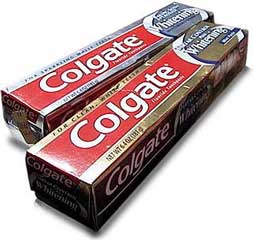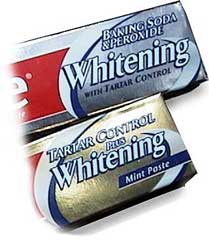Back when I was a kid, the toothpaste market was pretty simple: Families with children used either Crest or Colgate (the latter of which, you may recall, boasted of using "MFP Fluoride," which was actually redundant because MFP stood for "maximum fluoride protection"); single people who were more worried about dating than about cavities used Ultra-Brite; and people who were concerned about their breath used Close-Up.

These days, with the dental hygiene world having made significant strides -- or else maybe just having figured out how to target more narrowly defined market segments -- the situation's way more complex. If you look at the toothpaste section at your local supermarket or drug store, you'll see a dizzying array of brands, most of which have diverse product lines that address a wide range of problems: anti-cavity, anti-tartar, anti-gingivitis, anti-halitosis, whitening, and various combinations thereof. All of which helps explain how the folks at Colgate-Palmolive came to market the following two toothpastes: Colgate Tartar Control Plus Whitening, and Colgate Whitening with Tartar Control.
Read those two product names again -- Tartar Control plus Whitening (which we'll call TC+W, for ease of reference) and Whitening with Tartar Control (W+TC). It's almost as if the Colgate crew couldn't decide which product attribute to make primary and which one to make subordinate -- so they did it both ways, thereby covering all the bases. And just to make things a bit more confusing, the packaging describes TC+W as being "For clean white teeth," while W+TC is "For sparkling white teeth." Wow, talk about clear and distinct product differentiation!
I had sort of noticed this redundancy out of the corner of my eye but didn't fully confront the situation until Colgate recently ran an ad in the Sunday coupons touting both TC+W and W+TC -- without giving the slightest hint of what distinction there was, if any, between the two. Hoping to learn more, I checked out Colgate's web site, where it turned out that the list of toothpastes didn't even include W+TC. My curiosity now kicking into high gear, I called Colgate's 800 consumer-info number to get the scoop.

"The big difference is that one of them has baking soda and peroxide," explained the friendly customer-service rep I spoke with. And indeed, this is clearly noted on the W+TC package, although there's no indication of how this affects the product's whitening ability, anti-tartar capacity, or anything else. When I asked the fellow if he could explain the benefits of baking soda and/or peroxide, he said, "To be honest, I don't know. I just know some people prefer to have it in there." And are the two products otherwise identical? "Yeah, I think so. I can see why you might find that confusing."
Well, that's very understanding of him. Just for the record, however, he couldn't explain the difference between "clean white teeth" and "sparkling white teeth." But hey, if I'm really concerned about keeping my teeth white, Ultra-Brite is still available -- in fact, just to add one last layer of redundancy, the brand is owned these days by Colgate.
(Colgate-Palmolive Company, New York, NY 10022; 800-468-6502)